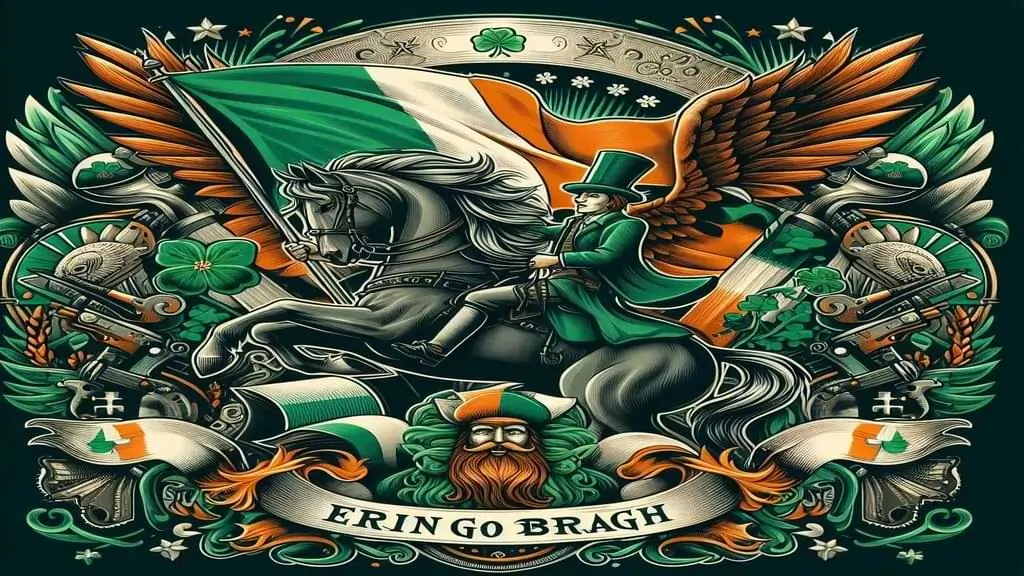Erin Go Bragh: Celebrating Irish Heritage and Pride

Origins of ‘Erin Go Bragh’
‘Erin Go Bragh‘ is a phrase with deep roots in Irish culture, symbolizing pride and identity. It originated as an Irish expression of loyalty to Ireland through various historical events.
Etymology and Translation
The term ‘Erin Go Bragh’ is an anglicized version of the Irish phrase “Éirinn go Brách” or “Éire go Brách”. This phrase translates to “Ireland until the end of time” or “Ireland forever”. The word “Éirinn” is derived from the dative form of “Éire”, meaning Ireland. Over time, English speakers adopted the phrase, leading to variations like “Erin Go Braugh”. By adopting this phrase, people affirmed their emotional attachment and loyalty to Ireland. These meanings carry a strong sense of pride and commitment to the nation.
Early Uses in History
Historically, ‘Erin Go Bragh’ came to prominence during the late 18th century. It was famously used by Irish nationalists as a slogan for independence. During the Irish Rebellion of 1798, this phrase appeared on flags and banners of the United Irishmen. This rebellion was a significant uprising against British rule, and the slogan underscored a demand for Irish autonomy. Later, it emerged in the United States in the 19th century, especially among Irish immigrants. They used it to express their heritage and unity. This phrase remains a potent symbol of national pride and resistance, particularly during celebrations like St. Patrick’s Day.
Symbolism in Irish Independence

“Erin go Bragh” has played a significant role in Irish independence, symbolizing pride and perseverance. Its use during historical uprisings and its influence on modern politics highlights its lasting impact on Ireland’s identity.
Use During Rebellions
During the many uprisings in Ireland, “Erin go Bragh” became a rallying cry. This phrase, meaning “Ireland Forever,” was more than just words—it was a symbol of hope and defiance. It adorned flags and banners during major events like the 1798 Rebellion. This emblem provided a sense of unity among those fighting for independence, reinforcing their shared goal.
The green in the “Erin go Bragh” flag symbolized Irish nationalism, while traditional symbols like the harp were incorporated into the design. These elements created a powerful image and allowed rebels to express their resistance in a meaningful way. Today, we can see how these symbols have carried through time, connecting us with those who fought for our freedom.
Modern Political Significance
In contemporary politics, “Erin go Bragh” still holds considerable weight. It is used by political parties that advocate for Irish cultural and political values. This enduring phrase represents a commitment to Ireland’s autonomy and unity, even in the face of globalization and shifting political landscapes.
Political rallies often feature the phrase to evoke patriotic sentiments and remind us of the ongoing struggle for full sovereignty. By continuing to embrace these symbols, we honor our heritage and keep alive the ideals that inspired Ireland’s quest for independence. As such, “Erin go Bragh” remains an integral part of our political discourse today.
Cultural Impact and Legacy
“Erin go Bragh” influences various facets of culture by impacting Irish-American identity, appearing in modern media, and being used in popular culture. This phrase, meaning “Ireland Forever,” is a symbol of Irish pride and unity.
Influence on Irish-American Culture
The phrase “Erin go Bragh” has deeply influenced Irish-American culture. It serves as a connection to Irish roots for many, emphasizing cultural heritage and pride in ancestry. As Irish immigrants arrived in America, they brought with them this powerful expression. It became a rallying cry during events like St. Patrick’s Day, showcasing the strong bonds within the community. Today, we see it displayed in parades and celebrations, reminding us of our shared history and struggles.
Irish-American identity has been shaped by this phrase, marking a sense of belonging and solidarity. It helps in bridging the gap between generations, passing down traditions and stories of resilience. For Irish-Americans, “Erin go Bragh” is more than just words; it is an enduring symbol of cultural pride.
Representation in Modern Media
In modern media, “Erin go Bragh” continues to hold significance. It appears in films, television shows, and music, often used to represent Irish characters and themes. The phrase symbolizes a connection to heritage and a celebration of Irish culture’s influence around the world. We see it used as a backdrop in movies, highlighting characters’ pride in their ancestry.
The inclusion of “Erin go Bragh” in various forms of media helps keep the phrase relevant, resonating with audiences across different backgrounds. It acts as a narrative device, setting the stage for stories of immigration, cultural identity, and belonging, making it recognizable and impactful.
Usage in Popular Culture
In popular culture, “Erin go Bragh” has found its way into everyday expressions. It’s often seen on merchandise like t-shirts, mugs, and home décor, appealing to those with Irish descent or admiration for Irish culture. The phrase is particularly popular during celebrations such as St. Patrick’s Day, where it’s displayed proudly on banners and decorations.
Musicians, like The Tossers, incorporate it into their work, using the message to convey loyalty and love for Ireland. This widespread use reflects the continuing relevance and emotive power of “Erin go Bragh” in expressing feelings of unity and heritage within popular culture.






